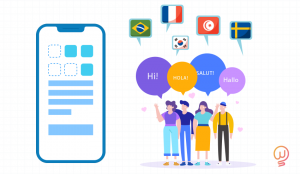
At each of these stages, different specialists work on the project, and a dedicated manager makes sure that everything goes according to plan and sends reports to the customer. After at least two months, and often longer, the first users of the finished site or application appear … And you can start working again on expanding its functionality, improving user experience, and so on.
By the way, we write exactly how we develop online stores and applications on each page with a description of the service.
Only usually it is not interesting to anyone. What could possibly be interesting here? Developers design, designers design! Well, everyone else there is doing some kind of magic, but not instantly, and they demand money.
However, as soon as it comes to a personal project, everything changes. It immediately becomes interesting where, what, how much and why. Let’s talk in order.
Why do these steps
Because different people work on the project and do very different things. Moreover, each subsequent stage requires the complete completion of the previous one, since all elements of the cycle are very dependent on each other. Whether you like it or not, you still won’t be able to do everything right away, even if you hire 100 instead of 10 people.
In this context, development can be compared to construction: no one bothers to choose wallpaper when there are no walls yet, but just sticking them will not work. And when there are already walls, you won’t start right away either – you need a roof, insulation, all sorts of putties. Moreover, if you still don’t give a damn about consistency, and stick this wallpaper just on a brick, they won’t last long, and it will be a hundred times more expensive to redo it later.
It’s the same with development.
Analytics
The first and most important step. Whether your project will take off literally depends on the quality of the analytics.
It doesn’t matter whether you are launching a unique technology startup or opening a shoe store, everyone needs analytics without exception. What for? To make a website or application that will meet the expectations of the target audience.
If your goal is to make a profit from the project, and not just pay for hosting and brag about having a website / application to your friends, you need to carefully prepare:
- understand who and why the product will be interesting;
- find out the features of the niche and collect references;
- discuss the idea with the target audience and find out what is important to them;
- Analyze your competitors to differentiate yourself from them.
As a result, if you don’t have a USP (unique selling proposition) yet, it will appear, and with it an understanding of what and how should work in order to achieve your business goals.
You can read more about what, how and why to analyze before launching a project here .
Development of technical specifications
Analytics results – pivot tables, charts, graphs and other beautiful and informative reports. By the way, they can and should be shown to investors. And also use when creating TK.
So, we have a formulated problem that the site or application will solve, and an idea of who and how exactly will use it for this purpose. It’s about time:
- develop a functional specification – requirements for the program;
- think over the overall architecture of the site or application – business logic, performance, scalability, and so on;
- choose technological solutions for each component of the project – framework, database, necessary integrations, etc.;
- determine how much time and money it will take.
Separately, the TK is used to draw up a cooperation agreement. A very detailed agreement, because as practice shows, any vague wording = a very specific headache for both parties. And in a contract based on TK, this will not happen. Here you have fixed deadlines so that the contractor does not delay, and prescribed obligations so that the customer cannot demand to do anything else for free.
Interface design
It is difficult even for specialists to imagine how a program based on dry TK will look and work. Moreover, even the best managers and customers delving into all the nuances may not understand each other. And in general, before giving the green light to a serious development, I want to see and feel how everything will look.
For this, prototypes of interfaces are created – all unique pages or screens. They can be fully interactive or static with explanations of how each element will work.
Until the final version of the interface is approved, the external part of the program with which the user will interact, no other work is being done.
UI Design
The most interesting part of the development from the point of view of the customer. At this stage, the bare frame of the site or application begins to be “dressed” in a beautiful design. You can break away and choose shades of corporate colors, view the proposed options for icons, pictures and animations, as well as much more, within the layout.
Backend and Frontend development
In parallel with the “creative” work of designers, developers are finally getting down to business. Backend developers are engaged in the creation of the same project architecture and business logic. At the lowest level, this is the design of classes and methods, as well as the choice of optimal technical solutions for tasks. And only then do they sit down and write code to make all the components of the future site or application work together.
Modern programming doesn’t require a developer to sit down and write a database or anything as serious from scratch. Their job is to use ready-made tools to create the most effective solutions. Sometimes it’s easy, sometimes it’s almost as hard as writing a database. For example, connecting a payment system to a website or application is a very simple task, which, by the way, like all other integrations with external services, is performed at this stage. On the other hand, for non-standard projects, in particular startups, you always need to spend a decent amount of time to figure out how to implement the original business logic.
Front-end developers or layout designers who are responsible for creating the user interface are much more fortunate. All that is required of them is to accurately transfer the design layout and all its logic to the UI of the site or application. This is also a long and painstaking, but completely uncreative work.
Testing
It’s not as hard to write code for a function as it is to make it work with others together.
Your application or site will consist of software blocks, each of which is responsible for its functionality and is connected to others. First, the performance of each module is checked, then they are assembled together, and again they are tested how they work. For small and standard projects, this stage can take several hours, for large-scale and non-standard projects – months.
At the same time, Frontend developers have their own difficulties – to make sure that everything works equally beautifully on all supported devices. One mistake in the code and now some button is no longer visible or does not work. This is a minimum, and as a maximum, problems can reach enchanting proportions.
As soon as these tasks are finished, the performance and security check of the system begins, and if everything is in order, then you can publish the result!
Release and revision
The last stage of the cycle is the publication of the application in the store or the site on the hosting. This completes the development. Then only technical support (required) and scaling (optional).
If you want to add new features or change old ones, the entire development cycle begins anew. Why? Yes, because you will already have new up-to-date data on the behavior of real users and any improvements should be made taking these factors into account.
And of course, those who order development in full-cycle agencies can immediately submit their project for promotion. For example, we are good at SEO, SMM, content marketing, and, of course, targeted advertising.
Conclusion
The development of a website or application consists of several stages, each of which is equally important for obtaining a quality result. Work on a project always starts with large-scale analytics and ends with a release. Two months or ten times more time can pass between these stages, depending on the unusualness of the ideas and the complexity of their implementation. In any case, the development is carried out in strict accordance with the pre-approved terms of reference, which also indicates the timing and cost of completing all tasks.


Average Rating